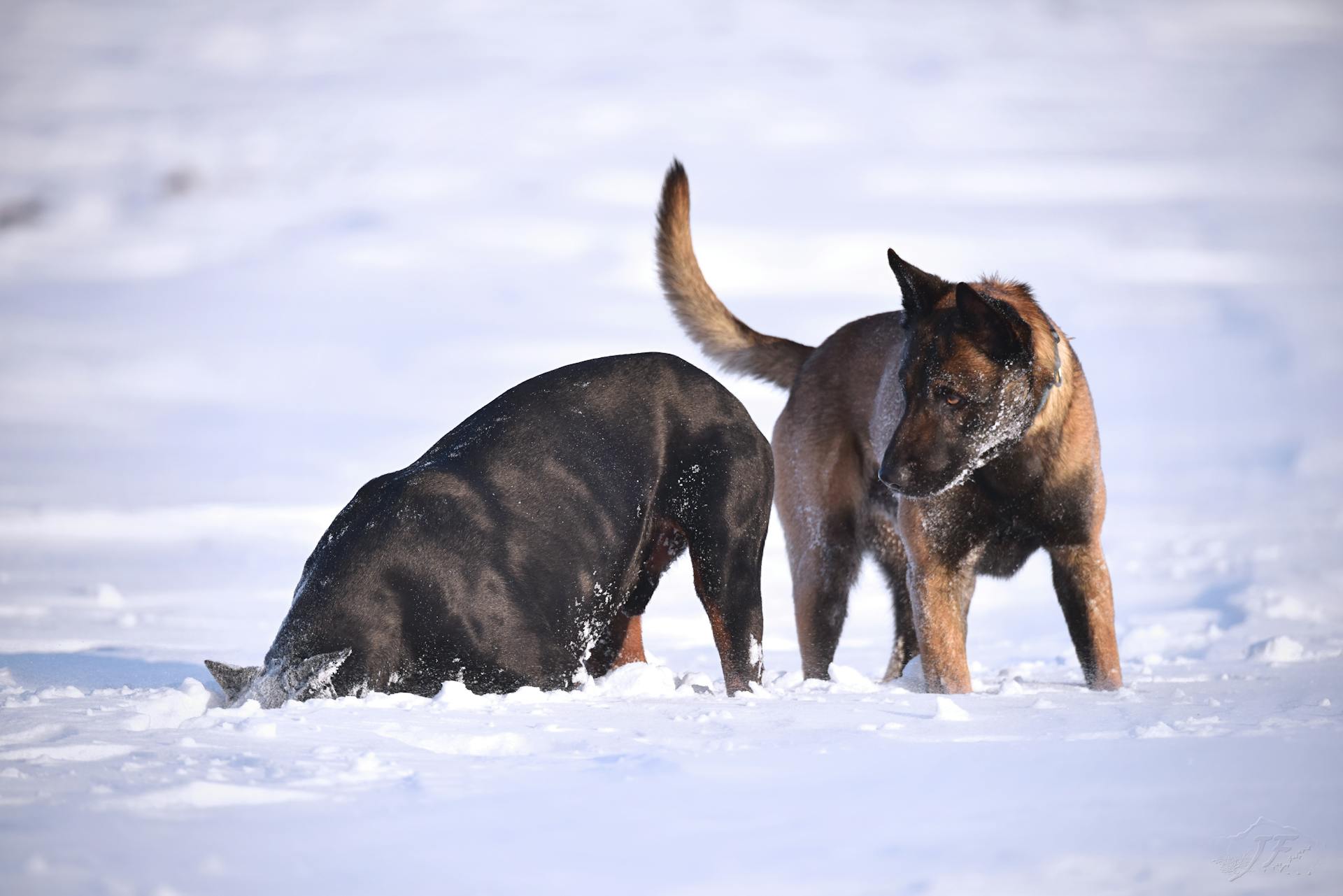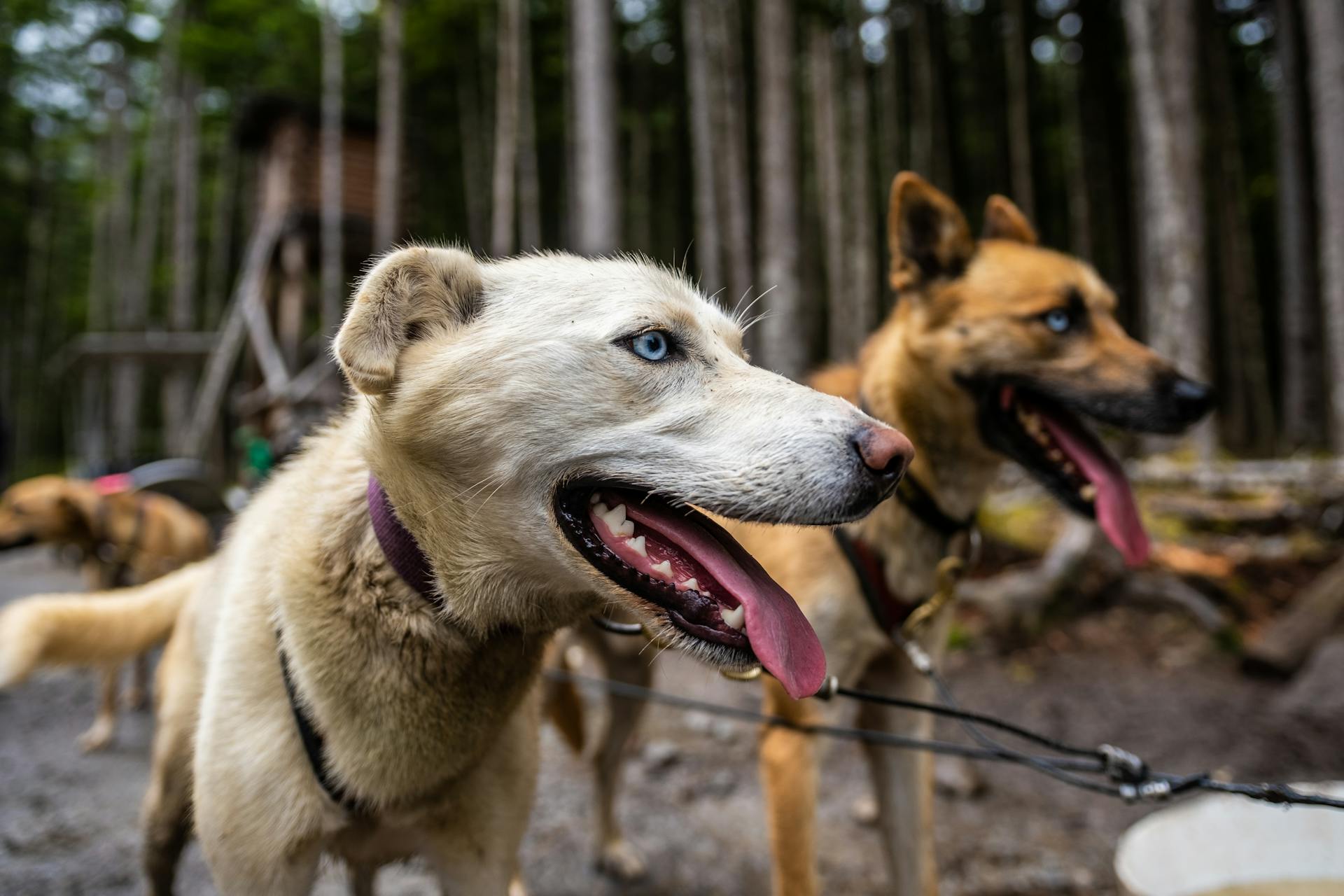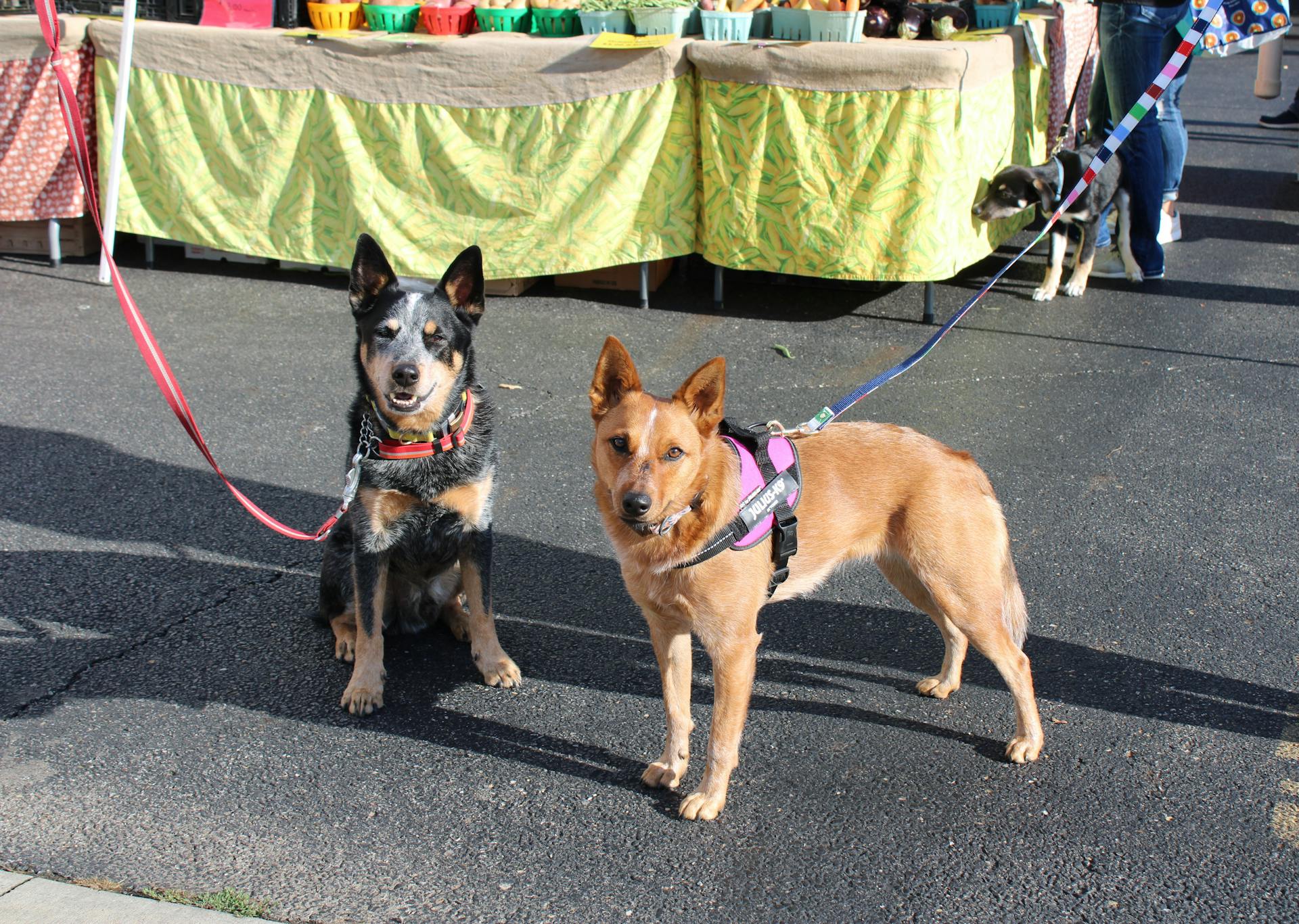
Dogs can develop a fear of certain people due to a combination of factors, including past experiences, breed characteristics, and individual temperaments.
Research suggests that dogs may inherit a predisposition to fear from their ancestors, which can influence their reactions to strangers.
If your dog is scared of a certain person, it's essential to identify the root cause of their fear to address it effectively.
Some dogs may be naturally more cautious or wary of strangers, which can be due to their breed characteristics or individual personalities.
For more insights, see: Why Does My Dog Not like a Certain Person
Understanding Fear in Dogs
Puppies go through predictable fear periods, which can start as early as 8-14 weeks old. During these periods, they're more likely to react to new things with fear.
Fear-based behavior in dogs can vary widely, from cowering under the table to lunging at visitors. They might whine, bark, or make other distress sounds, or display telltale body postures and visual signals like crouching or pulling back their ears.
Dogs can have many reasons to fear strangers, including genetics, poor socialization, anxiety, phobias, traumatic events, illness, or age. Genetics can play a role, especially in certain breeds or temperaments.
If your dog is acting fearful, they might pace, hide, pant, whimper, tremble, or run away. They might also exhibit obsessive behaviors like excessive grooming or clinging to you. A fearful dog may urinate or become immobilized, or engage in aggressive behavior like growling or snapping.
Reasons why your dog may be excessively fearful include genetics, poor socialization, anxiety, phobias, traumatic events, illness, or age. Here are some common signs of fearfulness in dogs:
- Crouching in a lowered body position
- Lying down and freezing
- Tension in body or face
- Mouth closed shut tightly
- Panting
- Yawning
- Tongue flicking
- Pulling back the corners of their mouth
- Dilated pupils
- Actively avoiding looking at something
- Showing a half moon shape of the white of their eye (called “whale eye”)
- Putting their ears back
- Tucking their tail
To help your dog overcome fear, you can try desensitization, counterconditioning, and distraction techniques. Consult with a veterinarian or a professional trainer and behaviorist to identify your dog's triggers and create a plan to address them.
Causes of Fear
Dogs can be scared of people for a variety of reasons. Genetics can play a role, with some breeds being more inclined to fear strangers due to their temperament or breed. Chow Chows, Bouviers des Flandres, Chinese Shar-Pei, and Doberman Pinschers are examples of breeds that may be less accepting of attention from strangers.
Explore further: Dog Breeds Watch Dogs
Poor socialization during the critical first weeks and months of life can also contribute to fearfulness in dogs. If your puppy is not exposed to many different people and situations, they may develop irrational fears and anxiety. Separation anxiety, loud noises, and being confined in a crate or small space can also trigger anxious behavior.
Traumatic incidents, such as abuse or neglect, can cause a dog to be fearful of a particular person or situation. Even a medical condition or illness can cause pain and stress, leading to anxiety. In some cases, cognitive decline can occur as your dog ages, causing them to become disoriented and fearful.
Puppy Fear Periods
Puppy fear periods are normal developmental stages that young dogs go through, where they're more fearful than usual. These periods are predictable and help puppies stay safe.
Puppies are often more afraid of new things during fear periods than they are before or after. This is because being cautious helps them avoid potential dangers.
Recommended read: Resource Guarding in Puppies
Fear periods can be triggered by new things, objects, or people that never used to stress them out. Puppies may react to things like a trash can on the side of the road or a person shoveling snow.
Most dogs go through fear periods and emerge from them without lingering fears being carried into adulthood. However, some dogs may need help to overcome their fears if they've had insufficient socialization, a traumatic experience, or are genetically predisposed to fearfulness.
Puppies are more fearful and cautious at certain predictable times in their development, which are associated with change in their life. These milestones are a natural part of their growth and help keep them safe.
Proper socialization is key to preventing anxiety or fear from taking hold in puppies. Exposing them to new people, places, and situations often, especially in the first weeks and months of life, can ensure positive first impressions.
For more insights, see: How to Introduce a Dog to a New Person
Genetics
Genetics play a significant role in a dog's fearfulness, and some breeds are more prone to anxiety due to their temperament or breed characteristics.
Some dogs may inherit a predisposition to fearfulness from their parents, which can be influenced by their breed. For example, certain breeds like Chow Chows, Bouviers des Flandres, Chinese Shar-Pei, and Doberman Pinschers may be less accepting of attention from strangers.
While socialization and training can help mitigate this, it's essential to consider a dog's genetic makeup when understanding their fearfulness.
A dog's genetic predisposition can be a major contributor to their anxiety, making it crucial to address their individual needs and personality traits.
Some breeds are naturally more fearful due to their genetic makeup, but this doesn't mean they can't be helped with proper training and socialization.
Here are some breeds that may be more prone to fearfulness due to their genetics:
Keep in mind that every dog is unique, and while breed characteristics may play a role in their fearfulness, it's essential to consider their individual personality and needs when addressing their anxiety.
Past Trauma
Past trauma can be a significant contributor to a dog's fearfulness. Many shelter dogs, especially those that are two years or older, have experienced abuse or neglect in the past.
Dogs that have a difficult past may exhibit fearful behavior, such as avoiding people or becoming aggressive when approached. This is often a result of their self-preservation mechanism, causing them to want to go in the opposite direction.
It's essential to understand what may have triggered your dog's fears, and this can be achieved by gathering information from the shelter or past foster parents. This knowledge can help you develop a plan to address your dog's specific fears.
Dogs that have experienced trauma may become fearful even in situations that seem harmless, such as a trip to the vet. Their past experiences can shape their behavior and reactions to various stimuli.
With patience, understanding, and the right approach, it's possible to help your dog overcome their fears and develop a more confident demeanor.
Socialization and Introduction
Waiting until full vaccination to socialize your dog can cause huge problems for your pup, so it's essential to start socializing as soon as possible.
Introducing a fearful dog to people should be done in small steps, allowing the dog to initiate contact and have the person offer treats. This gentle approach can help your dog feel more at ease.
Letting the dog initiate contact is crucial, as it helps them feel in control and builds trust. If your dog is fearful, it's best to start with small steps and gradually increase exposure to new people.
Rewarding your dog for good behavior is key to successful socialization and introduction. Be patient and consistent in your approach, and your dog will learn to associate new people with positive experiences.
Intriguing read: Merrick Dog Food for Small Dogs
Recognizing Fearful Behavior
Recognizing fearful behavior in dogs can be a challenge, but it's essential to address the issue to ensure your dog's well-being. A fearful dog may crouch in a lowered body position or lie down and freeze in response to a perceived threat.
Some common signs of fearfulness in dogs include tension in their body or face, a mouth closed shut tightly, panting, yawning, tongue flicking, and pulling back the corners of their mouth. These behaviors can be subtle, so it's crucial to pay attention to your dog's body language.
Dilated pupils, actively avoiding looking at something, and showing a "whale eye" (a half moon shape of the white of their eye) are also indicative of fearfulness in dogs. Additionally, a fearful dog may put their ears back, tuck their tail, or whine, bark, or make other distress sounds.
Here are some common body postures and visual signals that may indicate fearfulness in dogs:
- Crouching in a lowered body position
- Lying down and freezing
- Tension in body or face
- Mouth closed shut tightly
- Panting
- Yawning
- Tongue flicking
- Pulling back the corners of their mouth
- Dilated pupils
- Actively avoiding looking at something
- Showing a half moon shape of the white of their eye (called “whale eye”)
- Putting their ears back
- Tucking their tail
Reducing Anxiety
Reducing anxiety in dogs requires patience and practice. Exposing your dog to different scenarios, especially with a puppy, helps them become comfortable around various people and situations.
Proper socialization is key. This means taking your dog out and getting them accustomed to new people, places, and experiences. The sooner you start, the better, as this will help them form positive associations.
Desensitization and counterconditioning are effective techniques to reduce fear-based behaviors. Desensitization involves gradually introducing your dog to the stimulus, starting from a distance and gradually increasing proximity. Counterconditioning replaces negative associations with positive ones, helping your dog view the stimulus in a more positive light.
A fearful dog may exhibit behaviors such as pacing, hiding, panting, whimpering, trembling, or running away. They may also display physical signs like raised hackles, cowering, or avoiding eye contact.
Some common reasons for excessive fear in dogs include genetics, poor socialization, anxiety, phobias, traumatic events, illness, or age-related issues. Genetics play a significant role, with some breeds being more prone to anxiety and fear-based behaviors.
Here are some steps to help reduce your dog's anxiety:
- Consult your veterinarian to rule out any underlying medical issues
- Identify your dog's triggers and use desensitization, counterconditioning, and distraction techniques
- Create a safe space for your dog where they feel secure
- Consider using products like DAP or Thundershirts to help ease their fear
Remember, reducing anxiety takes time and patience. With consistent practice and the right techniques, you can help your dog feel more confident and secure.
Sources
- https://www.thewildest.com/dog-behavior/adolescent-dogs-go-through-fear-periods
- https://k9basics.com/why-is-my-dog-scared-of-strangers/
- https://wagwalking.com/symptom/why-is-my-dog-acting-fearful
- https://www.akc.org/expert-advice/training/dog-gets-scared-while-training/
- https://dogpsychology101.com/dogs-afraid-men/
Featured Images: pexels.com


